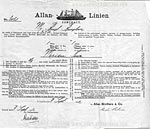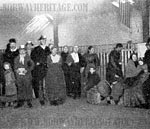Quarantine Stations (Plague houses)
History of the "Plague houses" in the harbour of New York.
|
 What do you know about the so called quarantine stations in the New York harbour? What do you know about the so called quarantine stations in the New York harbour?
During the time of different kind of deseases, the people who arrived by ships to the New York harbour were quarantined on special Islands.
"In an act to prevent the bringing in and spreading of infectious distempers in the colony, and stipulated that vessels having small-pox, yellow fever or other contagious diseases aboard should stop on their way to the city at these Island and there be quarantined, under heavy penalties for disobedience".
|
1758 - 1954
1758 -
Bedloe's (Liberty) Island - today "the site of the Statue of Liberty". Ships entering the harbour whose passengers and/or crew were infected with small-pox, cholera, yellow fever or other contagious diseases were held at the island's hospital.
In 1796, the quarantine facility was moved to Governor's Island.
1796 -
Nutten (Governor's) Island - This quarantine was not for long, due to the emergence of yellow fever on the island in 1799. The State Legislature made arrangements to purchase a larger site at Tompkinsville. The quarantine station began operating on that island the same year, 1799. (see below)
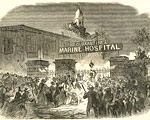 1799 -1858 -
Staten Island – Tompkinsville - known as the Marine Hospital Grounds. The night of September 1, 1858 people came to the Island and burned it down.
The remaining patients from Tompkinswille were transferred to different places. Those suffering from small-pox were moved to Blackwell's Island, patients with ship-fever were sent to Ward´s Island and the ones with yellow fever were sent to the floating hospital. 1799 -1858 -
Staten Island – Tompkinsville - known as the Marine Hospital Grounds. The night of September 1, 1858 people came to the Island and burned it down.
The remaining patients from Tompkinswille were transferred to different places. Those suffering from small-pox were moved to Blackwell's Island, patients with ship-fever were sent to Ward´s Island and the ones with yellow fever were sent to the floating hospital.
1847 -
Ward's Island - (Also known as Tenkenas Island (translated to Wild Lands) at the time of its appropriation from its native inhabitants to the Dutch Settlers in 1637).
Ship-fever patients were sent to this Island. The most important buildnings here were the Verplanck State Emigrant hospital, capable of holding 350 patients (it was the biggest hospital complex in the world during the 1850´s); the Refuge building for destitute women and children; and the New Barracks building for destitute male aliens.
1848 - approximately 180 had died in yellow fever at Ward´s Island, yet despite the constant protest of island citizens, some state government officials and other interest groups successfully blocked the closure of the station. But citizen demands to close the compound or plague house, as it was often called, continued to increase. The New York State Department of Mental Hygiene took over the immigration and asylum buildings in 1899, opening Manhattan State Hospital.
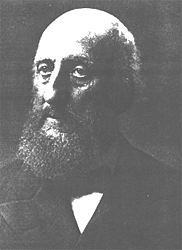 1854 - Blackwell Island had a small-pox hospital on the Island from 1854. It was design by James Renwick Jr (who also designed Saint Patrick's Cathedral) and built by convict labor. It was the hospital in New York devoted to small-pox cases. 1854 - Blackwell Island had a small-pox hospital on the Island from 1854. It was design by James Renwick Jr (who also designed Saint Patrick's Cathedral) and built by convict labor. It was the hospital in New York devoted to small-pox cases.
(The Island had several names changes - in 1921 from Blackwell's to Welfare and then in 1972 from Welfare to Roosevelt - as it is called even today).
Picture: James Renwick Jr |
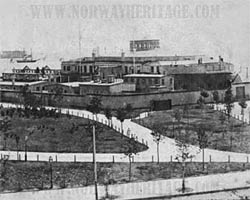
1850-1890 - Castle Garden (Immigrant landing center). From 1855 to 1890, Castle Garden was America's first official immigration center. About 8.2 million immigrants were entered here.
They used Blackwell Island if they had any smallpox patients and Ward´s Island for other deseaces.
|
|
 |
1857 -
Staten Island - Seguine Point - In early 1857, New York's Governor appointed three Quarantine Commissioners to find a new site. The Commissioners preference was Sandy Hook, but after having been refused the sale of the necessary parcel of land by the New Jersey's Legislature, they selected Seguine Point.
In the process, they had ignored the populated, nearby villages and the fact that its bay was too shallow to be easily accessed by the sea. Sometime just before midnight of May 6, approximately 20 vigilantes invaded Seguine Point and burned the place down. Seguine Point, was never rebuilt and Tompkinsville was continued in use. Instead, it would later be used as a burial ground for some of the immigrants that had succumbed to disease.
1859 - Floating hospital: steamship Falcon. The steamer Falcon, which had transported passengers to the gold rush fields of California, was refitted as a floating hospital. In late June of 1859, most of the remaining patients with yellow fever were transferred here from Tompkinsville.
|
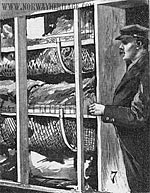 What happend when a ship arrived? What happend when a ship arrived?
Any yellow fever or cholera patients on an incoming vessels, a signal is set, and one of the steamers belonging to the New York quarantine service comes and brings the sufferers to the appropriate Island.
Immediately upon reaching the island they are stripped of their clothing, which is at once burned in a furnace constructed for that purpose, and they are placed in the sick wards.
|
April 23, 1863 - what is now known as the General Quarantine Act was passed, defining the quarantine establishment, authorizing its construction, creating the permanent office of Quarantine Commissioner, defining the duties and powers of the Commissioners and Health Officer, and establishing a general system of quarantine for the port in New York.
Upon arrival, quarantined vessels were instructed to anchor in the Lower Bay in a designated area which was no less than two miles offshore. Sick passengers and crew were transferred to Swinburne Island, while persons exposed to a communicable disease, but not sick, were held on Hoffman Island for the period of incubation.
1870 and 1873 - Swinburne Island & Hoffman Island. The best solution for a permanent quarantine was eventually determined to be the creation of artificial islands in the Lower Bay. Using rip-rap with sand fill, work began on the construction of Swinburne Island and Hoffman Island around 1866. Swinbure completed 1870 and Hoffman in 1873. The facilities were closed on both islands by the end of the 1930s.
|
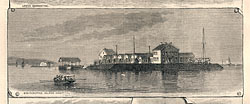
Picture: Swinburne Island |
Jan 1, 1892-1954 - Ellis Island
Those immigrants that were ill with contagious diseases, were removed from
the ships by
Medical Inspectors and transferred to Hoffman and Swinburne Island.
It was only the first and second-class cabin passengers. Passengers in the
third-class had to wait
for their examination later at Ellis Island.
Ellis Island also had quarantine houses at the Island.
More information about the Ellis Island Quarantine
More history about quarantine you will find here »
Source:
http://longislandgenealogy.com/ComingtoAmerica.htm
http://en.wikipedia.org/wiki
http://freepages.genealogy.rootsweb.com
Pictures:
Swinburne Island Swinburne Island hospital - Haper's Weekly (1879)
Tompkinsville riot - Harper´s Weekly (1858)
Swinburne Island - Harper´s Weekly (1870)
Castle Garden - Norway Heritage
Top image: Ellis Island Hospital and the Men´s Ward - freepages.genealogy.rootsweb.com |
|

 What do you know about the so called quarantine stations in the New York harbour?
What do you know about the so called quarantine stations in the New York harbour? 1799 -1858 -
Staten Island – Tompkinsville - known as the Marine Hospital Grounds. The night of September 1, 1858 people came to the Island and burned it down.
The remaining patients from Tompkinswille were transferred to different places. Those suffering from small-pox were moved to Blackwell's Island, patients with ship-fever were sent to Ward´s Island and the ones with yellow fever were sent to the floating hospital.
1799 -1858 -
Staten Island – Tompkinsville - known as the Marine Hospital Grounds. The night of September 1, 1858 people came to the Island and burned it down.
The remaining patients from Tompkinswille were transferred to different places. Those suffering from small-pox were moved to Blackwell's Island, patients with ship-fever were sent to Ward´s Island and the ones with yellow fever were sent to the floating hospital. 1854 - Blackwell Island had a small-pox hospital on the Island from 1854. It was design by James Renwick Jr (who also designed Saint Patrick's Cathedral) and built by convict labor. It was the hospital in New York devoted to small-pox cases.
1854 - Blackwell Island had a small-pox hospital on the Island from 1854. It was design by James Renwick Jr (who also designed Saint Patrick's Cathedral) and built by convict labor. It was the hospital in New York devoted to small-pox cases.



